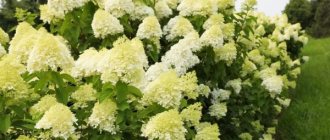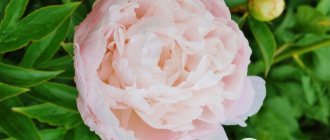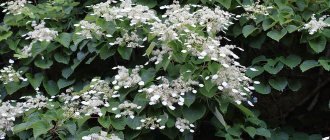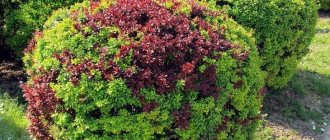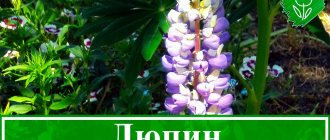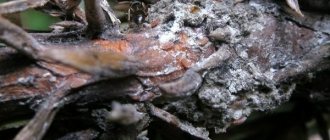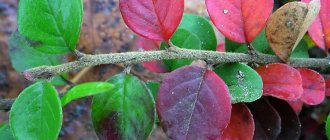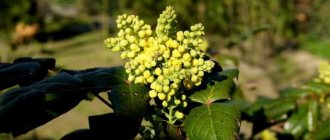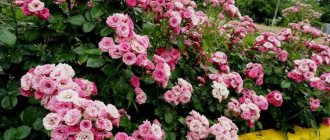Author: Elena N. https://floristics.info/ru/index.php?option=com_contact&view=contact&id=19 Category: Garden plants Published: February 17, 2019Last edits: April 23, 2021
- Growing conditions
- Dividing the bush
Tree hydrangea (lat. Hydrangea arborescens) is a species of plants of the genus Hydrangea of the Hydrangeaceae family, found in the wild in eastern North America. This is the most unpretentious and widespread species of the genus, which can easily withstand severe winter frosts.
Planting and caring for tree hydrangea
- Flowering: abundant, from mid-July to October.
- Planting: in spring before buds swell or during leaf fall.
- Lighting: in the morning - bright light, in the afternoon - partial shade or shade.
- Soil: moist, rich, light but fertile, well drained, with a pH of 5.5.
- Watering: regular and plentiful, especially during dry seasons: 1-2 times a week with a water consumption of 3-4 buckets for each plant.
- Feeding: in the spring, a handful of flower Kemira is scattered around the tree trunk, and potassium-phosphorus fertilizers are applied during the budding period. Until the end of the season, you can do another 2-3 fertilizing with fertilizer with a low nitrogen content.
- Pruning: pruning begins in the fifth year: the main procedure is carried out in the fall, and in the spring only sanitary cleaning is done and rejuvenating pruning is done once every 6-7 years.
- Reproduction: cuttings, layering and dividing the bush.
- Pests: Spider mites and green leaf aphids.
- Diseases: powdery mildew, downy mildew (perenospora) and chlorosis.
Read more about growing tree hydrangea below.
Pest and disease control
Most hydrangea diseases are caused by improper care and maintenance conditions. These are chlorosis, leaf burns, rotting of the root system, yellowness, leaf fall. In these cases, it is enough to adjust the regime, adjust the watering and fertilizing schedule, and create shade.
Fungal diseases are treated with special drugs - fungicides and antiseptics. To do this, you first need to get rid of damaged areas and excessive moisture. Viral ringspot has no cure, so diseased shrubs will have to be removed before the disease spreads further.
The most dangerous enemy of tree hydrangea is nematodes, which are difficult to control. Don't forget about routine preventative treatment to minimize the risk of damage. Among other parasites and pests, hydrangea is loved by slugs, aphids and spider mites, which can be eliminated mechanically and with insecticides.
Photo: tsvetovodovklub.ru
Botanical description
Tree hydrangea is a shrub from 1 to 3 m high with a rounded crown and slightly pubescent shoots. The leaves of Hydrangea tree are elliptical or ovate, 6 to 20 cm long, with jagged edges and a heart-shaped base, bare on the underside of the blade. Their upper side is green, the lower side is gray. A few sterile flowers with a diameter of about 2 cm, together with small fertile flowers, are collected in corymbs up to 15 or more centimeters in diameter. At the moment of opening, the white flowers have a greenish tint, then the green disappears, and by the end of flowering the inflorescences turn pink. The fruit of tree hydrangea is a capsule up to 3 mm in size. The plant blooms profusely and for a long time from the first half of July to mid-autumn.
Growing hydrangea in the garden - planting and care
The culture is distinguished by its rapid growth, love of moisture, demanding soil composition and winter hardiness. This species tolerates lime in the soil more easily than other hydrangeas.
- Callas after flowering - care features
What to plant next
Next to the tree hydrangea, low-growing and ground cover plants in green, pink or white shades, as well as shrubs, whose decorative peak occurs in the spring months, will find their place.
- Ground cover plants to maintain soil moisture and allow as few weeds to grow as possible. Periwinkle or tenacious are suitable for this role - they grow well in partial shade.
- Low hedges made of holly, boxwood, barberry, spirea or even dwarf thuja: they will support large inflorescences and create a clear outline of the composition.
- Larger shrubs with spring flowering: mock orange, gray spirea, lilac, forsythia, almond. This way the composition will remain decorative throughout the season.
- Ferns, hostas, mantle and astilbe will complement hydrangea in a mixborder, adding structure and shades
- Decorative coniferous plants will serve as a spectacular backdrop for our shrubs and will help acidify the soil.
You can experiment with bright shades near the hydrangea if you like compositions with a dense concentration of color, like stained glass windows or kaleidoscopes.
You can assemble a composition only from hydrangeas with different shades and vigor of growth to form a multi-level three-dimensional landscape.
Planting tree hydrangea in open ground
When to plant
The planting time for tree hydrangea is chosen taking into account the climate of the area. In the north, it is better to plant it in early spring, before the sap begins to flow, as soon as the soil in the garden thaws, and in areas with a mild, warm climate, hydrangea can be planted both before the buds swell and after the leaves fall.
How to choose the right place for a plant? Hydrangeas prefer well-lit areas in the first half of the day, which are in the shade in the afternoon. Tree hydrangea does not like the wind: its flowers quickly fade in places that are blown through. The plant needs moist soil, so do not plant it close to trees and shrubs so that they do not absorb moisture intended for hydrangea from the soil: the distance from the tree hydrangea bush to any other plant should be at least 2 m.
How to plant
The best planting material is three to four year old tree hydrangea seedlings. When purchasing seedlings with an open root system, pay attention to its condition, but it is better to purchase planting material with closed roots. Before planting, water the seedling abundantly, remove it from the container and shorten its roots to 20-25 cm. If rotten or dry roots are found, you need to trim them too.
Planting hydrangea in the fall and caring for it in the garden
When planting in poor soil, a hole is dug with a diameter of about 50 and a depth of 65-70 cm, but if the soil on the site is fertile, then the depth may be less - about 50 cm. In general, the size of the hole depends on the size of the root system of the seedling and the amount of soil on it . In the center of the hole, pour a mound of pre-prepared soil mixture of humus, chernozem, sand and peat in a ratio of 2:2:1:1 with the addition of 50-60 g of complex mineral fertilizer. Place the seedling on a mound, straighten its roots and fill the remaining space with the same nutritious soil mixture. Then compact the surface of the trunk circle and water the plant generously at the root.
Caring for tree hydrangea
Growing conditions
Tree hydrangea in open ground requires regular and abundant watering, especially during the hot, dry period. In addition, you will need to loosen the soil in the tree trunk and remove weeds, add fertilizer to the soil, prune the hydrangea and protect it from diseases and pests.
Watering tree hydrangea is carried out 1-2 times a week with water at a temperature of 20-25 ºC, pouring at least 3-4 buckets of water under each plant. If the plant lacks moisture, its leaves droop and begin to turn yellow, the flowers dry out, and the hydrangea loses its decorative effect. Therefore, make sure that the soil in the tree trunk circle does not dry out. After watering or rain, the surface is carefully loosened, trying not to damage the root system located at a shallow depth, while simultaneously removing weeds. To protect the soil from rapid loss of moisture, you need to mulch the surface around the plant with a layer of peat or humus, in which case you will have to water, loosen the soil, and weed much less often - about once every 10 days.
- Echinacea: picking, optimal conditions for a flower
In order for hydrangea to be attractive throughout the growing season, it is necessary to feed it with both mineral and organic fertilizers. In early spring, a handful of Kemira flower is scattered in the tree trunk circle, which contains not only the nitrogen, phosphorus and potassium necessary for each plant, but also a group of important microelements. The second feeding, consisting of 30 g of potassium sulfate and 50 g of superphosphate per plant, is applied during the budding period. In the future, you can apply fertilizer 2-3 more times, but be careful with nitrogen, since excess nitrogen leads to the appearance of a persistent green tint in hydrangea flowers. In addition, plants overfed with nitrogen do not winter well.
2-3 times in the spring, water the soil in the tree trunk circle and spray the crown with a weak solution of potassium permanganate. This is done to strengthen the strength of tree hydrangea shoots, which may not withstand the weight of a large number of large inflorescences. You can, of course, tie the branches to the support, but this will not add attractiveness to the plant.
Planting and caring for paniculata hydrangea in open ground
Of all the species of the genus, tree hydrangea is the most unpretentious and cold-resistant, however, new plant varieties brought from nurseries in warm regions require dry hilling and light shelter before wintering. Hydrangea bushes younger than four years old are covered with foliage or spruce branches. It is advisable to tie the branches of the bush together for the winter so that they do not break under the weight of the snow. But even if the plant suffers from frost, tree hydrangea recovers quite quickly in the spring.
Trimming
Tree hydrangea forms inflorescences on the shoots of the current year. The plant is not pruned for the first four years after planting, but later pruning is carried out twice a year, in spring and autumn. The main thing is autumn pruning, during which all faded inflorescences are removed.
If the hydrangea is not pruned, the bush becomes too thick and has a sloppy, neglected appearance. In the spring, before the start of sap flow, they do a sanitary cleaning of the bush, removing weak, thin, frozen, dried, damaged and thickening bushes, that is, growing towards the center, small or weakened zero shoots incapable of flowering. One-year-old shoots are shortened to 3-5 buds, from which new shoots with large inflorescences will appear this year.
Once every 5-7 years, rejuvenating pruning of tree hydrangea should be carried out: in early spring, all shoots older than five years are pruned at a height of 10 cm from the ground. However, the rejuvenation of very old plants is extended for three years, otherwise they may die.
Pests and diseases
Tree hydrangea can be damaged by spider mites and green leaf aphids - sucking insects that feed on the cell sap of leaves and young shoots of the plant. There is no point in wasting time trying to destroy hydrangea pests with folk remedies; it is better to immediately begin treating the shrub with an acaricide solution. Actellik, Fitoverm, Aktara, Sunmite cope well with sucking pests.
- Gomphrena: cultivation, care, types and varieties
Among the diseases, tree hydrangea can suffer from powdery mildew, downy mildew (perenospora) and chlorosis. Fungal diseases are treated with fungicides. For example, when a whitish coating of powdery mildew appears on the leaves, the hydrangea should be treated as quickly as possible with a solution of Bayleton, Quadris, Topaz, Fundazol or another drug of similar action. For peronosporosis, the plant is treated with biofungicides Gamair, Alirin-B or Fitosporin. Solutions are prepared in accordance with the instructions of the manufacturer of the chemical product, strictly observing the dosage and interval between treatments.
As for chlorosis, which manifests itself as discolored spots on the leaves, it usually occurs from an excess of humus in the soil or a lack of iron in it.
Propagation of tree hydrangea
Tree hydrangea propagates by cuttings, dividing the bush and layering. Professionals also use grafting and generative methods for this purpose, but for amateurs they are too labor-intensive, expensive and unreliable.
Dividing the bush
The tree hydrangea bush can be divided both in spring and autumn: the bush is dug up and taken apart in such a way that each division necessarily contains renewal buds. Plant parts of the bush in pre-prepared holes. If you carry out the procedure in the spring, by autumn parts of the bush will already take root in new places.
Reproduction by layering
This is also a fairly easy to implement propagation method that gives good results. In spring, annual shoots are bent to the ground and placed in pre-made grooves up to 10 cm deep so that the apical section, about 20 cm long, remains above the surface. The layer is fixed in this position, and the groove is filled with fertile soil. Throughout the season, the cuttings are watered and fed together with the mother plant, and in the fall or next spring it is separated from the bush and planted in a new place.
Propagation by spring and summer cuttings
This method of propagating tree hydrangea is used most often. Spring cuttings are cut in early June so that there is a heel at their base - a small part of last year's shoot. Summer cuttings are harvested in July from the apical, non-lignified part of the shoot. The cuttings should have 1-2 internodes. The upper leaves on them are shortened by half, the lower ones are removed. For successful rooting in conditions of high air humidity, you will need an installation that produces fog, and a soil mixture of two parts peat and one part sand is used as a substrate, although cuttings can also be rooted in leaf soil covered with a layer of sand 3-4 cm thick. Planting is carried out at an angle of 45º, the top of the greenhouse is covered with a transparent cap. Rooted cuttings spend the first winter in a cold greenhouse or basement, and in the spring they are planted in the ground. Next winter, the cuttings are well covered with spruce branches, and a year later they can already spend the winter without shelter.
Tree hydrangea varieties
Not many varieties of tree hydrangea are grown in garden plots. The best of them are:
- hydrangea tree Grandiflora is a shrub 1.5-2 m high with a crown up to 3 m in diameter. The leaves of the plant are light green, up to 16 cm long. Cream-white flowers up to 2 cm in diameter are collected in corymbose inflorescences up to 20 cm in diameter. Abundant flowering continues from June to September;
- Annabelle is a tree-like white hydrangea up to 1.5 m high, with a crown up to 3 cm in diameter and with inflorescences up to 25 cm in diameter. This variety blooms at the same time as Grandiflora. Annabelle's annual growth is 20 cm;
- Hydrangea tree Pink Annabelle - a form of the Annabelle variety with dark pink inflorescences that gradually become bright pink;
- Sterilis is a variety with flowers collected in dense hemispherical inflorescences, the weight of which bends the branches. At the moment of opening, the flowers are greenish-white, then the green tint disappears, and the inflorescences remain white until the very end, without acquiring a pink tint;
- Hayes Starburst is one of the new varieties with narrower leaves than other hydrangeas and with spherical inflorescences up to 25 cm in diameter, consisting of white double flowers;
- White Dome is a bush up to 130 cm high with an oval beautiful crown. The inflorescences consist of small creamy-white fertile and snow-white sterile flowers. The variety is winter-hardy, its shoots perfectly withstand the weight of the inflorescences and do not bend;
- Incredibol is a vigorous, hardy variety, similar to Annabelle, but with even larger spherical creamy-white inflorescences with a subtle yellowish-lime tint;
- Invincibelle is the very first variety of tree hydrangea with colored inflorescences: dark pink flowers open on the plant, and until the end of flowering only the intensity of their color changes.
Reviews
The variety Invisible surprised us with its vitality! Only planted in the ground, after an unsuccessful winter in a container, it began to increase its green mass and is already pleasing the home with flowers. Absolutely not demanding. Only abundant watering and shading. Beauty, I can't stop looking at it. This is what she will be like in two years!
Julia
Annabelle is a huge bush. Several years ago it was dug up from an old plant from neighbors in the country. It looked like a tree, not a bush. The height is under 3 m, I would never have believed it if I had not seen it myself. I limit the growth of my bush by pruning. Flowers in huge caps - in two of my palms. Reminds me of summer clouds. Flowering lasts for a long time, almost a month! I love it very much.
Natalia

